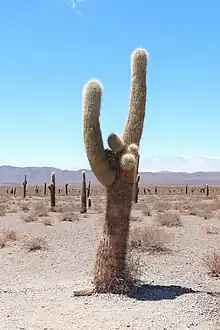Los Cardones National Park
Los Cardones National Park is a protected natural area of arid, semi-desert mountains in the Andean Northwest of Argentina. The park is famous for its tall, stout cactus, the cardon grande, also known as the Argentinian saguaro. The park was named for the photogenic cactus, which grows throughout the park. Paleontologists might want to visit to search for dinosaur remains or to view prehistoric fossils that are well preserved in the park's dry climate.
Understand

It is a large park, covering an area of 65,000 hectares.
History
The park was created as part of the Argentina national parks system in 1996 when the government purchased the land from private landowners.
Landscape
The park covers a highland landscape dominated by mountains from 2,700 meters up to the peak of Cerro Malcante, which stands out with an elevation of 5,070 meters high. In between are valleys, ravines, and sierras. Some areas reflect an Andean highland terrain while there are also lowland areas with streams and small vegetation.
Flora and fauna
More than 100 bird species inhabit the park, including the massive Andean condor, which can often be seen soaring on thermal air currents above the park.
Snakes and lizards are common in the park, but most visitors will spot herds of guanaco roaming everywhere. The guanaco and their cousins, the vicuña, are both related to the domesticated alpaca and llama. A number of other animals, including the gray fox, the chinchilla, and the armadillo might be seen as well.
Climate
Get in
By car
From Salta, drive south on RN-68 for about 50 km. At El Carril, turn left on RP-33 and continue for about 75 km.
Fees and permits
The park gates are open daily 09:30 - 18:00.
Get around
See
- Piedra del Molino is a massive granite rock formation standing tall at 3,600 meters. Climb to the top for panoramic views of the park landscape.
Do
- Hike - the park has only a couple official marked trails, but visitors can often find a local guide in nearby towns to lead them into other parts of the park. The park's Secret Trail is ridiculously short, but the Enchanted Valley Trail is a bit better at about 8 km with an elevation gain of 173 meters. The Enchanted Valley Trail passes through more verdant parts of the park with an opportunity to see flowers and a greater variety of wildlife.